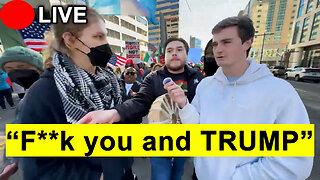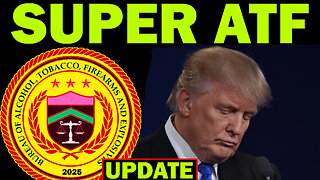Premium Only Content

The Men Who Stare At Goats
Cause Before Symptom - With Your Host James Carner
The Men Who Stare At Goats
The Men Who Stare at Goats is a non-fiction book by Jon Ronson that explores the U.S. Army's involvement in paranormal research, specifically focusing on a project known as the New Earth Army. This unit experimented with various psychic abilities, including the ability to kill goats by staring at them.
While the concept might seem absurd, the book delves into how serious the military was about these Parapsychology Research experiments. It's a fascinating exploration of the intersection between science, faith, and the military, and how far-reaching the search for new weapons and tactics can go.
The book's first five chapters examine the efforts of a handful of U.S. Army officers in the late 1970s and early 1980s to exploit paranormal phenomena, New Age philosophy, and elements of the human potential movement to enhance U.S. military intelligence-gathering capabilities as well as overall operational effectiveness. These include the First Earth Battalion Operations Manual (1979) and a "psychic spy unit" established by Army Intelligence at Fort Meade, Maryland, in the late 1970s. (This was the Stargate Project,[1][2][3][4] which the book never mentions by name.) Ronson is put on the historical trail of the "men who stare at goats"—Special Forces soldiers who supposedly experimented with psychic powers against de-bleated goats at Fort Bragg, North Carolina, at the now-decommissioned "Goat Lab" medical training facility. He examines, and dispenses with, several candidates for the legendary "master sergeant" (Chapter 2) who was reported to have killed a goat simply by staring at it, in the earliest days of the program. A martial arts instructor named Guy Savelli claims to be the one.
In the middle third of the book (Chapters 6–11), the author leaps to the present day—i.e., 2004, just after the Abu Ghraib abuse revelations—and attempts to make connections between the earlier (now terminated, and mostly discredited) military programs and the abuses resulting from the post-9/11 War on Terror (Abu Ghraib, Guantanamo Bay, psyops in Iraq, etc.). This includes the use of the children's song "I Love You" from Barney & Friends on Iraqi prisoners-of-war. A purported linking element is the alleged use of music and subliminal messaging at the 1993 Waco siege and other FBI operations. Another is the private business "franchises" and consultancies that retired members of the "psychic unit" later pursued as civilians. A connection is also proposed between these "privatized" psychics and the mass-suicide of members of the Heaven's Gate cult in 1997.
The final section of the book (Chapters 13–16) leaps backward to the 1950s and attempts to connect the Army psychic program, and later interrogation techniques, with the CIA's MK-ULTRA "mind control" research program and the notorious death of Army researcher Frank Olson in 1953. Ronson spends time with Olson's son Eric as he attempts to uncover the mystery of his father's death. Eric suggests that Frank Olson was murdered, not simply because he knew too much but, rather, that he was having a crisis of conscience and seriously entertaining the notion of going public with all that he knew. The narrative ends with the suggestion that the "psychic warriors" are now back in business working for the U.S. military again, possibly in support of assassinations.
Key points from the book:
* The New Earth Army: This was a secret unit within the U.S. Army that experimented with paranormal abilities, such as telekinesis and mind control.
* The Goat Experiment: One of the most infamous experiments involved soldiers attempting to kill goats by staring at them, focusing their energy on their hearts.
* The Search for a Psychic Weapon: The military was motivated by the hope of developing a psychic weapon that could be used in combat without leaving a trace.
* The Ethical Implications: The book raises important questions about the ethics of such experiments, especially when involving animals.
* The book is a blend of humor, intrigue, and a touch of the absurd, providing a unique perspective on the history of military experimentation.
Ronson's book was met with mostly positive, often glowing, reviews: the Boston Globe opined that it is "a hilarious and unsettling book.... Ronson comes off as an unusual cross between Comedy Central's Jon Stewart and The New Yorker's Seymour Hersh." The New York Times' Janet Maslin stated that "Ronson sets up his book perfectly. It moves with wry, precise agility from crackpot to crackpot in its search for the essence of this early New Age creativity....".
Some critics, however, were skeptical of what they considered Ronson's shaky logic and some of his bolder assertions. Alex Heard's review in U-T San Diego was subtitled "Goats tries hard to link psychic-spy projects from the past to today's events, and mostly fails". In many instances, he wrote, "...there isn't a link. Instead there's a progression of occurrences that don't connect in a meaningful way. The result is a strange new blend: Conspiracy theory meets Six Degrees of Kevin Bacon.... You're left feeling like you've been told a shaggy-goat story."
And of course the movie with George Clooney was based off this book.
During the Soviet era, parapsychological research was conducted in some forty different institutes -- greatly exceeding the activity in the United States. The Soviet military program entailed more than 100 remote viewers. Remote viewers were also actively used by law enforcement agencies and by the KGB. High profile psychics were also employed to shield prominent figures, such as premier Gorbachev, from enemy psychic attack. Since the fall of the USSR, this activity has been greatly reduced.
Soviet & Czechoslovakian Parapsychology Research
The "men who stared at goats" in the U.S. Army in the 1970s were trying to pull ahead of Soviet psychic research initiatives, many of which are described in this unique volume. They involve telepathy, psychotronics, psychokinesis, and out-of-body experiences such as remote viewing. This is the widely cited and quoted report prepared by U.S. Army Medical Intelligence and Information Agency for the Defense Intelligence Agency in 1975. Recently released through the FOIA, it has only been available in nearly illegible PDF editions. This transcription presents the full report with four major new addenda: biographical trace data on the researchers and subjects named; relevant imagery; a complete study done by members of the Hungarian Academy of Sciences on the Pavlita (psychotronic) generator, with Pavlita's participation (in 1987); and a recent Pravda news article on weaponizing psychotronic research. An excellent set of bibliographic endnotes is provided for those interested in further information.
The Soviet and Czechoslovakian Parapsychology Research: The DIA Report from 1975 released by the Defense Intelligence Agency (DIA), delves into the Soviet Union and Czechoslovakia's research efforts in parapsychology. The focus was on phenomena like telepathy, psychokinesis, and remote viewing, with the goal of understanding potential military applications.
Key findings and areas of interest:
* Government Support: Both the Soviet Union and Czechoslovakia had government-backed programs investigating parapsychological phenomena. This suggests a belief in the potential military utility of these abilities.
* Research Centers: Dedicated research centers and institutes were established to study parapsychology, indicating a significant investment in this field.
* Methodology: The report details the experimental methods used by Soviet and Czechoslovakian researchers, which often involved controlled conditions and rigorous testing procedures.
* Notable Figures: The report highlights specific individuals and their contributions to parapsychological research in these countries.
* Potential Applications: The DIA was interested in the potential military applications of parapsychological abilities, such as enhanced intelligence gathering or remote influence.
Areas for Further Exploration:
* Specific Experiments: A more in-depth analysis of individual experiments and their results could provide valuable insights into the scope and limitations of Soviet and Czechoslovakian parapsychological research.
* Ethical Considerations: The ethical implications of studying and potentially weaponizing parapsychological abilities were likely a concern for the DIA.
* Cultural and Political Context: Understanding the cultural and political context in which this research occurred could help explain the motivations behind government support and the direction of research efforts.
* Comparison to Western Research: Comparing the Soviet and Czechoslovakian research to similar efforts in the West could provide a broader perspective on the global landscape of parapsychology.
The CIA released a report about this in 1975 and was declassified in 2004. Stating “Over the past 25 years, Soviet scientists have reported that abilities such as extrasensory perception, clairvoyance, and telepathy have been demonstrated in the laboratory under rigorously controlled conditions.
Many of these claims have been published in the Soviet technical and popular literature. Justhow far the Soviets have really gone in their efforts to learn about the mechanisms of human telepathy is not known. If the Soviet reports are even partly true, and if mind-to-mind thought transference can be used for such applications as interplanetary communications the Soviets have accomplished or the guiding of interplanetary spacecraft, a sscientific breakthrough of tremendous significance.
The soviets are known to be involved in the development of inferential measurement and complex system modelling techniques. IMCSM is especially adapted for application to the examination and study of many interacting parts, even when the behavior of the objects are partly or mostly determined by features of which the researcher is unaware or which he cannot observe. Soviewt parapsychology research would probably be an ideal subject for the application of the IMCSM technique. If IMCSM is applied, the likelihood of a Soviet breakthrough in parapsychology is greatly increased. The Soviets are leaders in deveIopment of this technique and will probably apply it to parasychology research.”
While the exact extent of their research and its findings remain somewhat classified, it's clear that the Soviets invested significant resources into exploring the potential of parapsychological phenomena.
Here are some key aspects of their research:
* Government-funded Research: The Soviet government actively supported parapsychological research, often through military or intelligence agencies. This provided significant funding and resources for these projects.
* Dedicated Institutes: Several specialized institutes were established to focus on parapsychological research, such as the Institute of Psychophysics in Moscow.
* Rigorous Testing: Soviet researchers employed rigorous scientific methods and conducted controlled experiments to test parapsychological abilities.
* Military Applications: The primary motivation for Soviet parapsychology research was to explore potential military applications. This included using psychic abilities for intelligence gathering, remote viewing, and even influencing enemy forces.
* Notable Figures: Several prominent Soviet scientists and researchers were involved in parapsychology studies, contributing to the body of knowledge in this field.
A Notable Figure: Leonid Vasiliev
One of the most prominent figures in Soviet parapsychology was Leonid Vasiliev. He was a psychologist and physiologist who conducted extensive research into telepathy and other paranormal phenomena.
Vasiliev's experiments often involved twins, believing that their close genetic connection might enhance their psychic abilities. He conducted numerous studies on telepathic communication between twins, as well as other forms of extrasensory perception (ESP).
Some of his notable experiments included:
* Telepathic Communication: Vasiliev conducted experiments where twins were separated into different rooms and asked to transmit and receive thoughts or images.
* Remote Viewing: He explored the possibility of individuals being able to perceive distant locations or events without physical senses.
* Psychokinesis: Vasiliev also investigated the ability of individuals to influence physical objects with their minds.
Vasiliev's work contributed significantly to the Soviet understanding of parapsychology and helped to establish a foundation for further research in this field.
Notable Soviet Parapsychology Experiments
Soviet parapsychology research produced a number of notable experiments, often focused on telepathy, psychokinesis,and remote viewing. Here are a few examples:
Telepathy Experiments
* Twin Studies: As mentioned earlier, Leonid Vasiliev conducted extensive experiments using twins to study telepathic communication. He believed that their close genetic connection might enhance their psychic abilities.
* Card Guessing: A common experiment involved one person focusing on a randomly selected card and another person attempting to guess it.
Psychokinesis Experiments
* Dice Rolling: Researchers would attempt to influence the outcome of dice rolls using mental energy.
* Object Movement: Experiments were conducted to see if individuals could move or bend objects without physical contact.
Remote Viewing Experiments
* Location Identification: Participants were asked to describe distant locations that they had never visited before.
* Future Events: Some experiments involved attempting to predict future events using psychic abilities.
The Rhine Experiments
While not strictly Soviet, the Rhine experiments conducted by J.B. Rhine at Duke University had a significant influence on Soviet parapsychology research. His work on card-guessing and other ESP phenomena was widely studied and discussed in the Soviet Union.
It's important to note that many of these experiments were conducted in secrecy, and their exact methods and results may not be fully publicly available. Additionally, the scientific community remains divided on the validity of parapsychological research, with many critics arguing that the evidence is insufficient or flawed.
Here are some additional examples of Soviet parapsychology experiments:
Remote Viewing Experiments
* Project Scan was a Soviet remote viewing program that aimed to explore the potential of individuals to perceive distant locations or events. Participants were often given coordinates or descriptions of places and asked to provide detailed descriptions of what they saw.
* The "Star Gate" Project was a similar program conducted by the U.S. government, which was heavily influenced by Soviet research.
Psychokinesis Experiments
* The "Poltergeist" Phenomenon: Soviet researchers investigated cases of unexplained physical phenomena, such as objects moving or levitating, often attributed to psychokinetic abilities.
* Biological Effects: Some experiments explored the possibility of using psychokinetic energy to influence biological processes, such as plant growth or animal behavior.
Telepathy Experiments
* Group Telepathy: Researchers studied whether groups of people could collectively transmit and receive telepathic messages more effectively than individuals.
* Animal Telepathy: Some experiments focused on the possibility of telepathic communication between humans and animals.
It's important to note that many of these experiments were conducted in a highly classified environment, and their exact methods and results may not be fully publicly available.
Additionally, the scientific community remains divided on the validity of parapsychological research, with many critics arguing that the evidence is insufficient or flawed.
The conclusions drawn from Soviet parapsychology experiments were often mixed and controversial. While some researchers claimed to have found evidence of paranormal phenomena, others were skeptical of the results and argued that the experiments were flawed or lacked sufficient scientific rigor.
Here are some key points to consider:
* Lack of Consensus: There was no widespread consensus among scientists regarding the existence or nature of parapsychological abilities. Many experiments produced inconsistent results, making it difficult to draw definitive conclusions.
* Criticism of Methodology: Critics often pointed to methodological flaws in parapsychology experiments, such as inadequate controls, experimenter bias, or small sample sizes.
* Skepticism from Mainstream Science: The mainstream scientific community generally remained skeptical of parapsychological claims, often citing a lack of solid evidence and the difficulty of replicating experiments.
* Government Interest: Despite the scientific skepticism, both the Soviet Union and the United States maintained an interest in parapsychology research, often motivated by the potential for military applications.
It's important to note that parapsychology remains a controversial and fringe field of study. While some individuals and organizations continue to investigate these phenomena, the mainstream scientific community generally considers them to be pseudoscience.
Beyond the Iron Curtain: Parapsychology Research Worldwide
While Soviet and Czechoslovakian research was significant, parapsychology has been explored globally. Here are some additional points:
Western Research
* J.B. Rhine: A pioneer in American parapsychology, Rhine conducted extensive experiments at Duke University,primarily focused on card-guessing and other ESP phenomena.
* The Rhine Research Center: This institution, founded by Rhine, continues to conduct parapsychological research and maintains a large database of experimental results.
* Princeton Engineering Anomalies Research (PEAR): A prominent research group at Princeton University, PEAR conducted experiments on psychokinesis and related phenomena.
Other Notable Research
* Mahatma Gandhi: The Indian leader was known to have an interest in parapsychology and claimed to have experienced paranormal phenomena.
* Sir Cyril Burt: A British psychologist, Burt conducted research on telepathy and other psychic abilities, though his work has been criticized for methodological flaws.
Modern Trends
* Quantum Mechanics: Some researchers have explored connections between quantum mechanics and parapsychology, suggesting that quantum phenomena might provide a theoretical framework for understanding psychic abilities.
* Neuroscience: Advances in neuroscience have led to investigations into the neural correlates of parapsychological phenomena, attempting to identify brain regions or patterns associated with psychic abilities.
Despite ongoing research, parapsychology remains a controversial and fringe field of study. The mainstream scientific community generally considers it to be pseudoscience due to the lack of consistent and replicable evidence.However, there are still individuals and organizations dedicated to exploring these phenomena.
Let's explore some of the more in-depth and controversial aspects of parapsychology research:
The Ganzfeld Technique
* What is it: This technique involves creating a sensory deprivation environment to enhance psychic abilities.Participants are placed in a dimly lit room, wearing blindfolds and listening to white noise.
* Purpose: The goal is to reduce sensory input, allowing the mind to focus on internal signals or information from external sources.
* Results: While some studies have reported positive results, critics argue that the Ganzfeld technique is susceptible to experimenter effects and other methodological flaws.
The Sheep-Goat Effect
* What is it: This refers to the idea that people can be divided into "sheep" and "goats" based on their susceptibility to paranormal phenomena. "Sheep" are believed to be more receptive to psychic experiences, while "goats" are less susceptible.
* Controversies: The concept of the sheep-goat effect has been criticized for being unscientific and for perpetuating stereotypes.
Quantum Mechanics and Parapsychology
* Connection: Some researchers have proposed that quantum mechanics, a branch of physics that deals with the behavior of particles at the atomic and subatomic level, might provide a theoretical framework for understanding parapsychological phenomena.
* Arguments: Proponents suggest that quantum entanglement, a phenomenon where particles become connected regardless of distance, could explain non-local communication or telepathy.
* Criticisms: Critics argue that the connection between quantum mechanics and parapsychology is speculative and lacks empirical evidence.
The Role of Expectation and Belief
* Influence: The power of expectation and belief has been studied in parapsychology research. Some experiments have suggested that a participant's belief in their own psychic abilities can influence their performance.
* Placebo Effect: The placebo effect, where a person experiences a positive outcome due to the belief that a treatment will be effective, may also play a role in parapsychology research.
These are just a few of the more complex and debated topics within parapsychology. The field continues to be a subject of controversy, with ongoing discussions about the validity of its research and the existence of paranormal phenomena.
Quantum Mechanics and Parapsychology: A Controversial Connection
The relationship between quantum mechanics and parapsychology is a fascinating and controversial topic. Some researchers have suggested that the principles of quantum physics might provide a theoretical framework for understanding paranormal phenomena. However, this connection is highly speculative and lacks empirical evidence.
Key Arguments for a Connection:
* Non-Locality: Quantum entanglement, a phenomenon where particles become connected regardless of distance, is often cited as a possible mechanism for non-local communication or telepathy.
* Uncertainty Principle: The uncertainty principle, which states that it is impossible to know both the exact position and momentum of a particle simultaneously, has been used to explain the apparent randomness or unpredictability of psychic phenomena.
* Quantum Consciousness: Some researchers have proposed that consciousness itself might be a quantum phenomenon, existing at a subatomic level. This could potentially explain how psychic abilities might function.
Criticisms and Challenges:
* Lack of Evidence: Despite the theoretical arguments, there is no concrete experimental evidence to support a direct connection between quantum mechanics and parapsychology.
* Oversimplification: Critics argue that the application of quantum principles to parapsychology is often oversimplified and fails to consider the complexities of biological systems.
* Alternative Explanations: Many phenomena attributed to psychic abilities can be explained by other factors, such as chance, coincidence, or psychological biases.
It's important to note that the connection between quantum mechanics and parapsychology is a highly speculative and controversial topic. While some researchers find it intriguing, the mainstream scientific community remains skeptical due to the lack of empirical evidence and the challenges of applying quantum principles to complex biological systems.
Quantum consciousness is a speculative theory that posits that consciousness itself might be a quantum phenomenon,existing at a subatomic level. Some researchers have proposed that this theory could provide a theoretical framework for understanding paranormal phenomena, such as psychic abilities or near-death experiences.
Key Arguments for Quantum Consciousness:
* Subjectivity of Experience: The subjective nature of consciousness, the fact that it is experienced from a first-person perspective, has led some to suggest that it might be a non-physical phenomenon that cannot be fully explained by classical physics.
* Quantum Entanglement: The idea that consciousness might be entangled with other quantum systems could explain phenomena like telepathy or remote viewing.
* Brain as a Quantum Computer: Some researchers have proposed that the brain might function as a quantum computer, capable of processing information in ways that are not possible with classical computers.
Criticisms and Challenges:
* Lack of Evidence: There is no direct empirical evidence to support the theory of quantum consciousness. It remains a highly speculative hypothesis.
* Biological Complexity: The brain is a complex biological system, and it's unclear how quantum effects could be sustained or measured at the macroscopic level.
* Alternative Explanations: Many phenomena attributed to psychic abilities can be explained by other factors, such as chance, coincidence, or psychological biases.
It's important to note that quantum consciousness is a highly controversial and speculative theory. While some researchers find it intriguing, the mainstream scientific community remains skeptical due to the lack of empirical evidence and the challenges of applying quantum principles to complex biological systems.
We know after project paperclip, america took the spacecraft rocketeers and the societs took the biological scientists. The biology and parapsychology seemed to be perfected by the soviets right after world war two. This means they could have easily created human-animal hybrids and figured out telepathy using IMCSM. My argument has always been about mankind faking aliens for control. The soviet breakthroughs in telepathy and creating fake aliens proves my point.
While the United States did recruit many German rocket scientists through Operation Paperclip, the Soviet Union also sought to acquire German scientific expertise, particularly in the fields of biology and medicine.
* Operation Paperclip: The U.S. program focused on scientists involved in rocket technology, aviation, and other related fields.
* Soviet Counterpart: The Soviet Union conducted a similar operation, focusing on scientists with expertise in biology, medicine, and chemical warfare. These scientists were often brought to the Soviet Union to work on various research projects.
It's important to note that both the U.S. and Soviet programs faced ethical dilemmas due to the involvement of scientists who had worked for the Nazi regime. While the programs contributed to advancements in technology and science, they also raise questions about the recruitment of individuals with potentially dark pasts.
Gemini AI proves we took the rocketeers and russia took the biological ones. American perfected spaceships and russia perfected ET’s. We know that after the Bolshevik revolution, Russia became controlled by the bankers. This was the compartmenatlization of the elite for the big event of releasing a fake alien agenda. Spirits and demons cannot manifest here. That’s against the laws that the lord put into place. The watchers guided the bloodlines to split up research and development between the two great countries. The cold war was a cover so they can perfect and create the alien agenda. Angels and demons need man to build the stairway to heaven to merge both the veil and earth so the watchers can rule again. The soviet and american Parapsychology Research gave them the knowledge to build the perfect lie. The devil can’t get people to stop believing in god until he builds a world that doesn’t need god.
I do believe the antichrist will be a genetically modified man but a nordic nazi with blue eyes and blonde hair. Tall and cut. The perfect eugenics specimen that will claim he comes from another solar system. All will marvel at his beauty and how he saved the world. He will have telepathic capabilties thanks to Parapsychology Research from Russia and America which will be genitically put into him. We never were trying to build a super solider. We were trying to build alien races to back up the lie of the big bang and evolution. This lie has been in the works for thousands of years and we are so close to the coming of the beast. I do believe the men who stared at goats, actually had the capabilities of supernatural powers and we found out where this resides in the body so we can manufacture and modify it. Soon, all of us will have to make a choice. To continue our faith in God or believe in the lie that we live in a universe and not a bubble in water.
sources
Gemini AI
https://www.cia.gov/readingroom/docs/CIA-RDP96-00792R000600350001-3.pdf
-
 23:50
23:50
marcushouse
17 hours ago $5.00 earnedStarship Is About to Do Something It’s Never Done Before - A Huge First!
47.4K17 -
 LIVE
LIVE
FrizzleMcDizzle
2 hours agoElden Ring Seamless COOP
113 watching -
 41:56
41:56
CatfishedOnline
2 days agoKinky Man Sends 401k to Romance Scammer from Ghana!
32.6K11 -
 1:53:55
1:53:55
Nick Shirley
20 hours ago $8.57 earnedIRL Confronting Anti-Trump & Anti-Elon Protesters
38.4K136 -
 16:18
16:18
Tactical Advisor
1 day agoRetiring My Patrol Rifle | Old vs New
34K2 -
 22:29
22:29
JasminLaine
21 hours agoAwkward Silence After Poilievre FACT CHECKS Reporter—Carney’s Face SAYS IT ALL
34.7K40 -
 9:48
9:48
VSOGunChannel
21 hours ago $2.35 earned25% of ATF Getting Fired? SUPER ATF on Hold?
32.9K31 -
 11:09
11:09
ariellescarcella
1 day ago"All 4 Of My Kids Are Trans" : NOOOOOO
30.7K39 -
 12:35
12:35
GoldenWebb
1 day ago $0.38 earnedMP5/K Super Safety
19.1K6 -
 2:45:42
2:45:42
Badlands Media
1 day agoDevolution Power Hour Ep. 343: System Shock
178K170